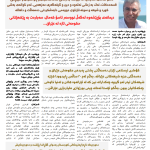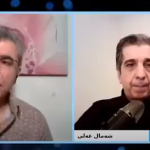Chapter 4 -New communism book
The Labour Party today resembles a metaphor in today’s capitalist system. The working class wants to free itself and human society from a system based on class exploitation. However, for this class to be able to do so, it must build the tools of struggle in the form of the apparatuses of class society. The creation of the Workers’ Party and its workers’ state goes against the goal of purging society and class systems. Therefore, the Workers’ Party and the workers’ government are not the ultimate goal for the workers. They are not considered sacred by this class and do not hold their true meaning. The party and the workers’ state are metaphorical components of the bourgeois party and state, which have a different meaning and content from what is prevalent in the intellectuals and culture of bourgeois society. Here, we will discuss the differences between the workers’ party and the bourgeois party and the relationship between the party and the class from a working-class perspective.
To simplify the discussion, we will first remove the party from its historical process and focus on the changes that occur in the class struggle. In the next chapter, we will discuss historical examples. Here, we present the general views and the communist worldview about the party.
In previous chapters, we have mentioned that communism and the party are appendices of the working-class struggle. The connection between the party and the working class is formed at the heart of this struggle. The communist perspective and worldview for this relationship are shaped through the participation of communists in the daily and continuous struggle of the working class, their pursuit of revolution, the seizure of power, and the transformation of the capitalist system.
However, there is a difference between the way the communist party and its views are embraced within the working class and how the bourgeois party is embraced within the bourgeois class and society. The science, tradition, code of conduct, and terms of reference of the bourgeois party are different from those of the communist party.
The method of capitalist production depends on the existence of the working class, as capital can survive by extracting surplus value from their labour. Additionally, the social production of capital gives the working class a social organization, empowering them to engage in social revolution. The working-class revolution is unique because, for the first time in history, a class comprising the majority of society collectively owns property, unlike revolutions led by other minority classes, such as landlords and the bourgeoisie, who transfer their private property to another minority. The collective ownership of the workers changes social and political relations and even human nature itself. As Gramsci states, “The basis which Marx has presented for political and historical science shows that ‘human nature’ is not separate, abstract, fixed, and unchangeable, but that human nature itself contains the historical destiny and determinism of social relations.” The working class alters the class nature of humanity by changing the social relations of capitalist production and eliminating the private property of capitalists. This concept of “political science, with definite content and rational formulation, relies on the need to view politics as an organic development.”*1
This organic development of politics within the working class entails the emergence of class consciousness among workers, which evolves through a historical process of class struggle. It is initially theorized by the intellectual class of the working class and later becomes a popular and organized movement through scattered daily and economic struggles. This movement represents the collective and general will of the socialist class, taking a definite form within the party.
As we mentioned earlier, the party is a product of the class struggle process for the working class. Initially, the working class seeks to establish a tool that unifies the power of the entire class. In the 19th century, the slogan “the power of the working class lies in its organization” gained prominence. This means that the party is not just a section with its own program, but an organization that represents and organizes the class as a whole.
During that time, the bourgeoisie was organized in various governmental, political, and economic apparatuses. In response, the working class also organized itself through trade unions and different political parties and factions. The party, in this context, becomes a means to unite and coordinate the power and efforts of the working class.
The philosophy behind the party goes beyond being a mere group with its own program. It is seen as a tool for the working class to bring about social revolution and transform the capitalist system into a communist system. The party should be capable of overthrowing the bourgeoisie and its government, taking ownership from the capitalists, and establishing a system of collective property and low-level council power.
To fulfil its role, the party must not only have the support and consent of the working class but also unite and coordinate the active and political elements within the class. Sectarianism and divisions within the working class, such as those based on communist, syndicalist, or anarchist labels, should be seen as obstacles to the social revolution. Instead, they need to be addressed and resolved in order to achieve the main goal of organizing the working class for a revolution that eliminates class and exploitation.
In summary, the party is not just a specific group or program but an organization that represents and organizes the working class. Its purpose is to unite the power of the working class and coordinate efforts towards a social revolution and the establishment of a new society without class and exploitation.
Here the meaning of party membership shifts, and every worker can and should be organized and have freedom within the party. Party discipline does not imply that the lower rank blindly follows the decisions of the upper rank within the organization. Rather, it means that the lower rank has the ability to participate in decision-making processes and to challenge decisions that go against their interests.
“”Centralism in the labour movement” refers to establishing stability in the organization of the actual movement by unifying the lower levels with decisions made from above, ensuring continuous participation of the lower elements, and elevating those lower elements within the leadership. This type of leadership guarantees sustainability and the continuous accumulation of experiences. It represents a temporary “state spirit” of the workers, contrasting the bureaucracy of government employees within the Labour Party. The aim is to prepare for the abolition of the party, government, and bureaucracy”. *2
In summary, the concept of party membership transforms, allowing all workers to be organized and free within the party. Party discipline implies active participation and the ability to challenge decisions. Centralism in the labour movement ensures stability, inclusivity, and the accumulation of experiences. Building a party for the workers is fundamentally different from constructing a minority government by the bourgeoisie, as workers have a shared interest in unity and the elimination of divisions. The aim is to create a new society through the collective power of the working class.
The process of building a party and its importance for the workers differs from the formation of a minority authority by the bourgeoisie. The bourgeoisie organizes the interrelations within its class based on the accumulation of capital and the protection of the capitalist system. The constant differences between capital fractions, the concentration of capital in the hands of a minority, and the gradual defeat of small capitalists shape the fate of all internal intellectual, political, and economic rivalries within the bourgeoisie.
In contrast, workers have no economic or competitive interests such as the accumulation of capital or encroaching upon the work, products, or property of others that would necessitate political competition or conflict. On the contrary, it is in the workers’ interest to unite and eliminate differences that hinder their ability to overthrow the exploiters from power as a collective force. This unity is crucial for the entire working class, including its various components, organizations, divisions, and divisions across different countries and nations. The working class, in its pursuit of building a new society for humanity, aims for a society that is not just for a particular class or group, but for all. There is no discussion here of a political or intellectual current that can change society solely through ideology or grant the privilege of building a state to communists because they possess a theory that expresses the conditions for the salvation of the working class. The entirety of the “Communist Manifesto” emphasizes the philosophy that workers, as a class, have the capacity to change the capitalist system and emancipate themselves. According to Marx, this forms the foundation for the creation of the party, as exemplified by the First International (The International Workingmen’s Association (IWA) (1864–1876).
As the party progresses and grows, the power of the elite upper rank diminishes, necessitating changes in the party’s organization and management methods. This goes beyond merely electing officials and implementing “democratic centralism.” The party becomes an organ in which any ordinary worker can participate in decision-making, and decisions are not monopolized by a group that remains in leadership positions indefinitely. The division of work within the party’s organs is designed to be simple and accessible, allowing every worker to take on responsibilities.
While the bourgeoisie organizes their parties based on parliamentary constituencies, workers’ organizations are based on their places of residence and work, which serve as the headquarters for the comprehensive struggle against the bourgeoisie. With each step, the Labor Party removes barriers between the party and the mass struggle, transforming from a specialized private organization to a mass organization that encompasses all levels and ranks. It paves the way for broad participation and policies that prevent the party from becoming a sect or a collection of bureaucratic employees. This is the fundamental difference between a workers’ party and a bourgeois party.
A workers’ party cannot and should not remain like elite or communist parties. It is built as the soul of the state and the future political society. Therefore, the activities, programs, policies, and organizational structure of the party reflect the spirit of the state’s actions and the changes in the future society’s governance and economic system. Each party represents a form of political society and a future economic system.
The workers’ party cannot organize, politicize, and plan for the state and economy in the same way as bourgeois parties. It serves as the soul of the workers’ state, aiming to prevent the division of politics due to the division of work. The party seeks the active participation of society and its compatriots in determining government policy, strategy, programs, and activities. The party’s philosophy of existence works towards a society that no longer relies on the party, where the gates of bourgeois defence have been broken, and society can govern itself without the need for the party.
According to Gramsci, “When the party is fully formed, it will no longer exist and will end historically. Every party bears the name of a class. It is evident that the party’s task is to eliminate the differences between classes. This happens when the party itself ceases to exist due to the eradication of classes, and its interpretation goes away.” *3
The communist worldview perceives the role of the party from the perspective of the working class as a temporary tool necessary to end bourgeois rule. After achieving this goal, the party and the workers’ government should as quickly as possible relinquish political and bureaucratic power, as part of the history of minority rule, and allow society to be free from such constraints. In a society where freedom is the recognition of everyone’s needs and voluntary participation in social production, direct connections between human beings are established, eliminating the need for legal centres, surveillance systems, interrogations, and leadership. This represents a current in which human capabilities continually grow and shape the philosophy of life.
When a worker becomes a member of the Workers’ Party, they should not lose their freedom of speech and political agency in the name of the party’s plans and decisions. Instead, the party should provide a framework that encompasses all views within the working class and its administration. Transparency in decision-making and practical steps is the outcome of active participation by all members. When workers are unable to actively engage in the party, members become passive under the party’s administration, leading to the disease of bureaucracy. Bureaucracy transforms and suppresses opposition forces, even if those forces align with the core interests of the party.” *4
The relationship between the party and the class is dialectical for the workers. The working class requires the structure of a political organization to succeed in the class struggle against the bourgeois system of government. However, the working class also needs the party itself, as a class apparatus, to transform into a non-class, non-political organization when it comes to power. As Saint-Simon stated, “The affairs of society must be managed by it, not to rule over humans.” This is not limited to abolishing the bureaucratic apparatus of the bourgeoisie and its army, as seen in historical events like the Paris Commune and the Soviet state. It is not enough for the employees of the workers’ government to receive equal wage as the professional workers, or for the apparatuses of the workers’ state to combine legislation and executive administrations. Instead, these steps should mark the beginning of building a system where the lower classes of society engage in legislative and executive duties as daily responsibilities, enabling broad participation. As Lenin expressed, “All cooks can rule in government.”
In socialism, as technology and communication flourish, the administrative system will gradually eliminate the need for political power and representative systems. Political power must be abolished, and direct participation by all compatriots in decision-making should replace political categorization. The Workers’ Party should serve as the instrument of this political and social revolution against the political apparatus of the state and party, which have shaped the history of class society and perpetuated the class system. Politics in human society entails awareness of dominant social relations, mastery of social organization, and collective human awakening, leading society towards genuine human civilization and eradicating the remnants of slavery and exploitation. It aims to eliminate repression and inequality.
With this understanding, it is important to compare the history of workers’ partisanship with different worldviews and the foundations of communist beliefs. We can examine how existing models have deviated from these views and how the bourgeois party model has influenced and dominated workers’ parties over the past two centuries. Specifically, we can discuss the models of Social Democrats and Bolsheviks, and then explore the model of workers communism and our history of work in the Communist Party.
Sources
1* https://asokamal.com/index/?p=1595
2* https://asokamal.com/index.?p=1635
3* Gramsci, Prison Notebooks, The Modern Prince, P151
4* https://asokamal.com/index/?p=1635








Add Comment